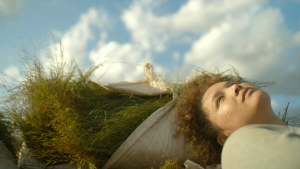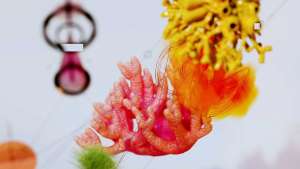Imagine a future in which water is a more sought-after resource than oil or gold. That human life depends on it in a very direct way, puts water right up there as a crucial asset that should be readily available to anyone.
But given the current global trend of resource privatisation, it is no stretch of the mind to think that bottled water could become a commodity that exists exclusively under the moderation of powerful multinational corporations within a few decades.
With the aim to spark thought and discourse regarding the subject of commodifying water, Joshua Dawson has produced a short film that combines real-world commentary with generated dystopian visuals.
Cáustico is a 4-minute video that consists of news announcements that were collected during 2014 and 2015. The narrative reports are on the subject of corporations buying key groundwater mining real-estate and distribution rights in drought-stricken regions, turning what many feel should remain a basic human right into a price-tagged market item.
It's set against a series of rendered visuals that depict ‘Generic City’ in the year 2036, an urban setting that has been ravaged by the effects of over drafting groundwater at the hands of Turquoise, a fictional corporation. The film shows dark and devastated civic areas in a landscape mired by vast, man-made sinkholes.
Striking architecture indicates the disparity of urban life. There's a marked difference between those who can afford the luxury of drinking water have moved below ground to specialised dwellings that are closer to the subterranean water sources. The project aims to highlight the destructive cycle of draining underground water which in turn creates more sinkholes, disrupting social and ecological equity.
We spoke to Joshua Dawson and asked him about the origin of Cáustico. He described a project that he led in South India and his architectural proposal submission to the Indian government regarding a hot spring and how it could benefit locals citizens.
“It was a project that attempted to integrate the ritualistic, the routine and the therapeutic forms of bathing into a single building complex. The revenue for the revitalisation would come from the therapeutic functions of spas etc. and would support the routine and ritualistic activities.
Various classes of people would use the same pool for different bathing purposes. I was accused of being too utopian and idealistic to attempt this and realised that the issue transcends an architectural intervention,” he said.
Soon after, Cáustico was born with help from esteemed Hollywood production designer Alex McDowell (who was Dawson’s professor).
“He teaches a class called World Building which is essentially the creation of a holistic set of conditions and rules from which multiple stories can emerge … we would discuss a big budget film called Paani by Director Shekhar Kapur that was on the privatisation of water.
Unfortunately [Paani] didn’t go into production. So I asked Alex if I could continue the dialogue as my graduation project at USC.”
Dawson is confident that Cáustico will inspire cautionary thinking on the subject of water conservation and proper treatment as it is a necessity not bound by region, but totally global.
“I think the project's success can only be measured by how many people take notice of this important issue. It baffles me how greed can drive people to think this is the next oil.
The Bolivian Water Wars already saw hints of what is to come and a troubling reality is how this is currently impacting slums and favelas, yet no one seems to be giving it any attention.
The film is a provocative message that is meant to do exactly that; to raise awareness by projecting a dystopian future.”
Cáustico is set to feature at the 2016 International Festival of Landscape Architecture held in The National Museum of Australia in Canberra. Joshua-Ashish Dawson is an architectural designer based in Los Angeles. He directed the short film with help from sound designer Nikki Guirre and visual effects artist, Bryan Chung.







